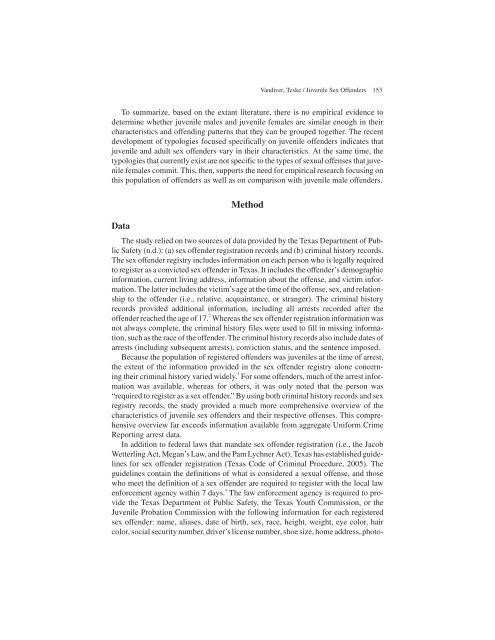Juvenile Female and Male Sex Offenders
Juvenile Female and Male Sex Offenders
Juvenile Female and Male Sex Offenders
You also want an ePaper? Increase the reach of your titles
YUMPU automatically turns print PDFs into web optimized ePapers that Google loves.
V<strong>and</strong>iver, Teske / <strong>Juvenile</strong> <strong>Sex</strong> <strong>Offenders</strong> 153To summarize, based on the extant literature, there is no empirical evidence todetermine whether juvenile males <strong>and</strong> juvenile females are similar enough in theircharacteristics <strong>and</strong> offending patterns that they can be grouped together. The recentdevelopment of typologies focused specifically on juvenile offenders indicates thatjuvenile <strong>and</strong> adult sex offenders vary in their characteristics. At the same time, thetypologies that currently exist are not specific to the types of sexual offenses that juvenilefemales commit. This, then, supports the need for empirical research focusing onthis population of offenders as well as on comparison with juvenile male offenders.DataMethodThe study relied on two sources of data provided by the Texas Department of PublicSafety (n.d.): (a) sex offender registration records <strong>and</strong> (b) criminal history records.The sex offender registry includes information on each person who is legally requiredto register as a convicted sex offender in Texas. It includes the offender’s demographicinformation, current living address, information about the offense, <strong>and</strong> victim information.The latter includes the victim’s age at the time of the offense, sex, <strong>and</strong> relationshipto the offender (i.e., relative, acquaintance, or stranger). The criminal historyrecords provided additional information, including all arrests recorded after theoffender reached the age of 17. 2 Whereas the sex offender registration information wasnot always complete, the criminal history files were used to fill in missing information,such as the race of the offender. The criminal history records also include dates ofarrests (including subsequent arrests), conviction status, <strong>and</strong> the sentence imposed.Because the population of registered offenders was juveniles at the time of arrest,the extent of the information provided in the sex offender registry alone concerningtheir criminal history varied widely. 3 For some offenders, much of the arrest informationwas available, whereas for others, it was only noted that the person was“required to register as a sex offender.” By using both criminal history records <strong>and</strong> sexregistry records, the study provided a much more comprehensive overview of thecharacteristics of juvenile sex offenders <strong>and</strong> their respective offenses. This comprehensiveoverview far exceeds information available from aggregate Uniform CrimeReporting arrest data.In addition to federal laws that m<strong>and</strong>ate sex offender registration (i.e., the JacobWetterling Act, Megan’s Law, <strong>and</strong> the Pam Lychner Act), Texas has established guidelinesfor sex offender registration (Texas Code of Criminal Procedure, 2005). Theguidelines contain the definitions of what is considered a sexual offense, <strong>and</strong> thosewho meet the definition of a sex offender are required to register with the local lawenforcement agency within 7 days. 4 The law enforcement agency is required to providethe Texas Department of Public Safety, the Texas Youth Commission, or the<strong>Juvenile</strong> Probation Commission with the following information for each registeredsex offender: name, aliases, date of birth, sex, race, height, weight, eye color, haircolor, social security number, driver’s license number, shoe size, home address, photo-


